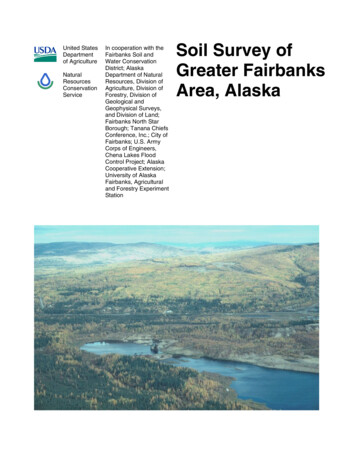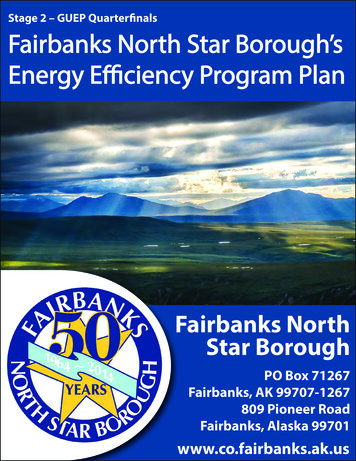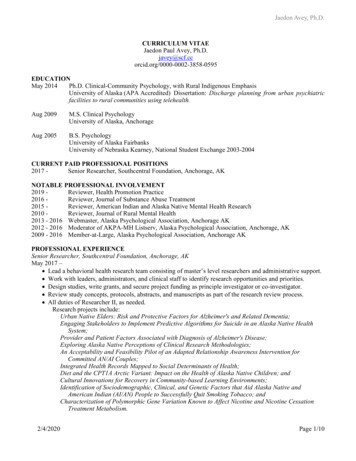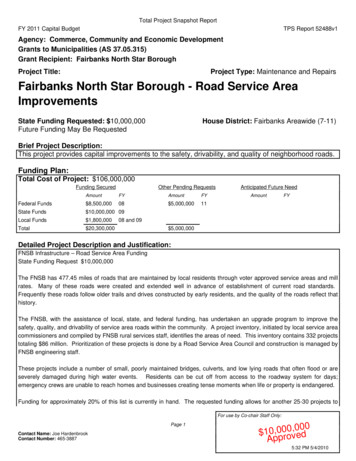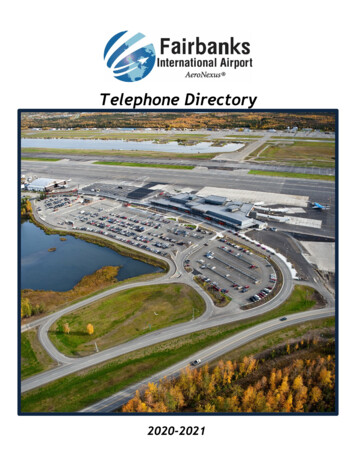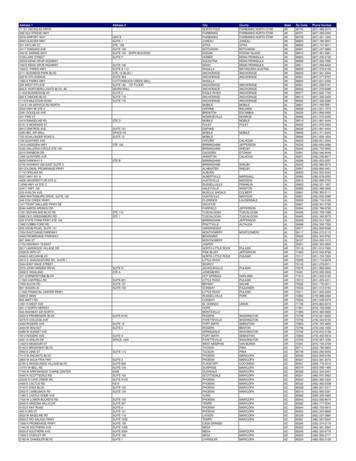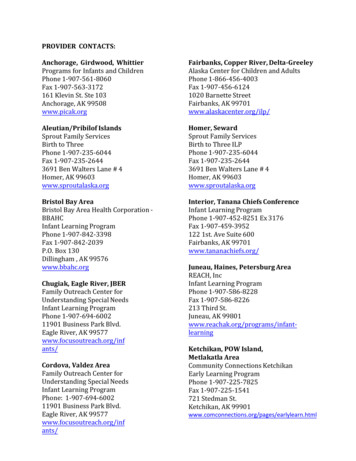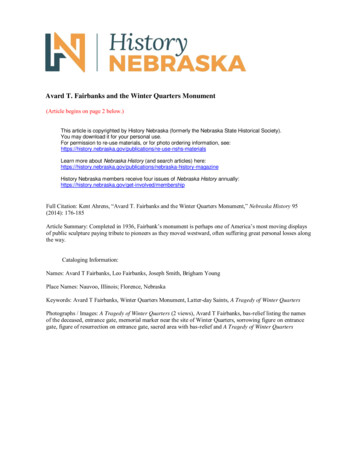
Transcription
Avard T. Fairbanks and the Winter Quarters Monument(Article begins on page 2 below.)This article is copyrighted by History Nebraska (formerly the Nebraska State Historical Society).You may download it for your personal use.For permission to re-use materials, or for photo ordering information, se-nshs-materialsLearn more about Nebraska History (and search articles) raska-history-magazineHistory Nebraska members receive four issues of Nebraska History /membershipFull Citation: Kent Ahrens, “Avard T. Fairbanks and the Winter Quarters Monument,” Nebraska History 95(2014): 176-185Article Summary: Completed in 1936, Fairbank’s monument is perhaps one of America’s most moving displaysof public sculpture paying tribute to pioneers as they moved westward, often suffering great personal losses alongthe way.Cataloging Information:Names: Avard T Fairbanks, Leo Fairbanks, Joseph Smith, Brigham YoungPlace Names: Nauvoo, Illinois; Florence, NebraskaKeywords: Avard T Fairbanks, Winter Quarters Monument, Latter-day Saints, A Tragedy of Winter QuartersPhotographs / Images: A Tragedy of Winter Quarters (2 views), Avard T Fairbanks, bas-relief listing the namesof the deceased, entrance gate, memorial marker near the site of Winter Quarters, sorrowing figure on entrancegate, figure of resurrection on entrance gate, sacred area with bas-relief and A Tragedy of Winter Quarters
AVA R D T. FA IR BA N K SA N D T HE W IN T ERQUA RT ER S MON U MEN TB Y K ENT A HREN SAvard T. Fairbanks’s Winter Quarters Monument in Nebraska stands as memorial tothe nineteenth-century Mormon pioneerswho did not survive the harsh travel West. Duringthe winters of 1846-47 and 1847-48, more than sixhundred members of the Church of Jesus Christ ofLatter-day Saints died in their encampment, calledWinter Quarters, on the banks of the Missouri Rivernear Omaha’s present-day Florence neighborhood.These men, women, and children were amongthe large group of church members immigratingwestward to the valley of the Great Salt Lake under the leadership of Brigham Young. Today, theirburial ground—which also memorializes the sixthousand Latter-day Saints who died enroute Westbetween 1846 and the completion of the railroad in1869—is commemorated by Fairbanks’s beautifullyexecuted sculptural program.In 1830 Joseph Smith (1805-1844) established hisfirst Church of Jesus Christ of Latter-day Saints inSeneca County, New York, with fewer than a dozenmembers. Within a few years church members established a large community in Kirtland, Ohio, nearCleveland. Unfortunately, Latter-day Saints communities were troubled by outside prejudice andSmith finally led his followers across the MississippiRiver into Missouri. By 1839, however, they wereagain faced with the same difficulties, and Smithbrought them back across the Mississippi into Illinois. They settled in Commerce and renamed itNauvoo, or beautiful place, which is the anglicizedspelling of traditional Hebrew and is referenced inIsaiah 52:27. A magnificent temple was built at Nauvoo and the community prospered, but prejudicesagainst the church again emerged. A dramatic climax was reached in 1844 when Joseph Smith andFigure 1, right: Fairbanks. A Tragedy of Winter Quarters, Winter Quarters Monument. 1936. Omaha, Nebraska.Author photo176 NEBRASKA history
FALL 2014 177
Figure 2: Avard T.Fairbanks. CourtesyDr. Eugene F. Fairbanks.his brother Hyrum were imprisoned for treason,and while imprisoned were murdered.Following the death of Joseph Smith, controversy developed among church leaders about whoshould succeed him. Brigham Young (1801-1877)assumed leadership as president of the Quorum ofthe Twelve Apostles in 1844, although he was notordained as the second president of the churchuntil 1847. Young continued to face leadershipcontroversy within the church and growing outsidehostility against church members in Nauvoo. Therefore, in February 1846 Young led the first group ofchurch members across the Mississippi toward theWest; other members followed in groups calledcompanies, or “camps of Israel.” Travel was extremely difficult and many died on the way, butthey finally reached Council Bluffs on the Iowabanks of the Missouri River in June 1846.As Richard E. Bennett wrote, “The problemsfacing the Latter-day Saints in the wilderness, estimated by late June 1846 at between three andsix thousand, were serious and complex. . . .”1 Thejourney across Iowa had left them exhausted, supplies were rapidly depleted, and the heavy rainsof March and April delayed their arrival at the Missouri River by weeks. Moreover, it was necessary178 NEBRASKA historyto construct a ferry to transport wagons across theriver, a time-consuming operation. Young decidedthat it was too late in the season to push west intorelatively unknown territory; instead the livestockshould be attended and crops planted in order tocontinue the journey the following year. While theferry was being constructed the Latter-day Saintsretreated to higher ground in order to escapeswampy water and mosquitoes.From camp they could see the PottawattamieIndian villages. In order to maintain good relationswith the Indians, Young ordered no contact withthem and that trading should be done collectivelyby camp leaders. (The tribes along the west bankof the Missouri were the Omaha, who in 1831had ceded their land in Iowa, and the Otoe andMissouria, with the Pawnee farther west.) Youngalso worked to maintain good relations with thefederal Indian agents for a number of reasons. Heunderstood that there was a certain mistrust thatthe Latter-day Saints might join with Indians tofight the United States government, and that thefederal agents kept the army at Fort Leavenworthinformed of their movement. More importantly,Young needed permission to winter in Indian territory. After President James K. Polk declared warwith Mexico in May 1846, officers from the Army ofthe West approached Young to request that a battalion of five hundred volunteers be formed to fightfor the United States in California. Young made agood bargain: the army got its Mormon Battalion,and in exchange the Latter-day Saints were grantedpermission to establish winter camp on Indian landon both sides of the Missouri River.The site of the future settlement of Florence,Nebraska, became known as Winter Quarters. Although a community of log cabins was built, manypeople lived in primitive mud huts. Young supervised construction of Florence Mill and they tradedwith friendly Native Americans, but despite thistheir diet was very limited to corn bread, salt bacon,and a little milk. By July 1846 nearly a third of thecamp was down with fever, the source of which wasmosquitoes in nearby swamps. Scurvy, tuberculosis,malaria, and unidentified fevers infested the camp.Before the settlement was finally abandoned, sixhundred men, women, and children died. Severalmembers of the Fairbanks family are among thoseburied at the Winter Quarters cemetery.The Fa irba nk s fa mily in A mer icatraces its history back to Jonathan and Grace Fairebanke, who migrated from Yorkshire, England,and built their home in Dedham, Massachusetts;
Figure 3: Fairbanks. BasRelief Listing the Namesof the Deceased, WinterQuarters Monument.1936. Omaha, Nebraska.Courtesy Dr. EugeneF. Fairbanksthe Fairebanke House (ca. 1637-1641) is regardedas the oldest surviving timber- framed house fromthe colonies. In 1846 a descendant, John BoylstonFairbanks, was among the pioneers at Winter Quarters, and he buried his father and his wife’s parentsthere. His son, John B. Fairbanks, born in 1855,became an artist of note, as did his two sons—J.Leo Fairbanks and Avard T. Fairbanks (1897-1987).Avard Fairbanks and his wife Maude had eight sonsand two adopted daughters. His children distinguished themselves in the sciences, medicine, thearts and related cultural activities.Although Avard Fairbanks’s work has not received the scholarly attention it deserves, he wasone of America’s most accomplished twentieth-century sculptors in the Beaux Arts tradition. He wasa precocious youth. When Avard was about twelveyears old his father took him along to New York,where the boy studied for a time at the Art StudentsLeague under James Earle Fraser. In New York healso became acquainted with Hermon A. MacNeil,Gutzon Borglum, Phimister Proctor, and Anna V.Hyatt, among others.2 By 1914 father and son hadtraveled to Paris, where Avard studied at the Écoledes Beaux Arts with Jean Antoine Injalbert, and atthe Académie Colarossi and École de la GrandeChaumière. The outbreak of World War I terminated their sojourn, and they returned to Utah.Back in America, Avard completed his highschool education and continued with his sculpture.In 1915 his work was included in the Panama Pacific Exposition, and in 1920 he joined the facultyat the University of Oregon to teach sculpture. Heremained on the faculty until 1928. However, hereceived a leave of absence from Oregon to takehis BFA degree from Yale University, and in 1927he received a Guggenheim Fellowship to pursuecreative sculpture in Europe and to study at theScuola Fiorentina de Pittura in Florence. In Italy hecompleted a bronze honoring the Archiconfraternitadella Misericordia and The Pioneer Mothers Memorial for Vancouver, Washington. While teaching atSeattle Institute of Arts in 1929, he completed the91st Division Memorial, Fort Lewis, Washington,which is regarded as one of his finest memorials.3In 1929 Fairbanks joined the faculty of the University of Michigan, where he taught until 1947;during World War II he spent some time workingFALL 2014 179
Figure 4: Fairbanks and J.Leo Fairbanks. EntranceGate, Winter QuartersMonument. 1936. Omaha,Nebraska. CourtesyDr. Eugene F. Fairbanksfor the automotive industry in Detroit. Among hiscontributions to industrial design were the ram forDodge automobiles as well as radiator ornamentsfor the Plymouth and Hudson.4 While at Michiganhe earned a Ph.D. in anatomy.The Latter- day Saints burialground seemed to have been all but forgotten until1924 when the Daughters of the American Revolution marked it with a plain board inscription, whichthey replaced in 1932 with a bronze plaque.5 (Areasof the cemetery continued to be used by the Florence community.) It was during his tenure at theUniversity of Michigan that Fairbanks conceivedand executed the sculptural program at WinterQuarters cemetery. On their drive back to Michiganfrom Utah, the Fairbanks family stopped in Nebraska, where they found the Winter Quarters cemeteryall but forgotten and in a state of neglect. The visit,however, stimulated Avard Fairbanks’s imagination. Family tradition mistakenly had it that JohnFairbanks and his wife had also buried their firstborn child at Winter Quarters. (The child had beenburied at Nauvoo.) Fairbanks began to imagine theprofound sorrow of a pioneer couple burying an180 NEBRASKA historyinfant child in this bleak winter landscape beforehaving to move on toward the West. This themewould evolve into the central figural groups atWinter Quarters cemetery.6When he was not teaching in Michigan, Fairbanks would return to Utah, where he oftenpresented demonstrations on sculptural techniques; he would build a model of clay and thentear it down to reuse the material. The subject ofa mother and father burying their child, whichbecame his presentation piece, was well receivedby audiences and gradually stimulated more andmore attention. As interest grew, Fairbanks continued working out details on progressively largermodels. Apparently it was a life -size version of thestatue that attracted the attention of church authorities when it was exhibited in 1934 at the 1933-1934Century of Progress International Exposition celebrating Chicago’s centennial.7Fairbanks proceeded with the project afterreceiving authorization from Heber J. Grant, president of the Church of Jesus Christ of Latter-daySaints, and from Omaha city commissioners.8 Asmaller version of the statue in plaster was shippedto New York City, where it was to be enlarged and
Figure 5: Fairbanks.Memorial Marker nearthe Site of Winter Quarters,Winter Quarters Monument.1936. Omaha, Nebraska.Courtesy Dr. EugeneF. Fairbankscast into bronze by Roman Bronze Works (figs. 1and 9). Ralph Vanni, who was trained in Italy, didFairbanks’s plaster work. Fairbanks’s eldest sonshad assisted Vanni in preparing the plaster cast,and when Fairbanks went to New York to makefinishing touches on the wax model he took themwith him to see the work at Roman Bronze.Back in Michigan, the sons again played animportant part in the next phase of the project—preparation of a nineteen-foot, figured bas reliefcontaining the names of those known to be buriedin the cemetery (fig. 3). Incising each letter was alaborious process, especially since the names werelisted alphabetically and the panel had to be alteredevery time another name was discovered. Spacewas left at either end of the panel in memory ofthose whose names were lost to history. This largepanel was cast by Gorham Company Founders,which specialized in casting fine bas relief panels.While Fairbanks was preparing the sculpture,David O. McKay and J. Reuben Clark, members of thechurch authority, traveled to Omaha in April 1936,where they signed a fifty-year lease with the stipulations that the church would landscape and beautifythe grounds. They also selected the monument siteand reviewed plans for the landscaping, which wasdesigned by Irvin T. Nelson of Salt Lake City, workingin collaboration with the sculptor. The landscapingwork was in progress by June 1936.9As the project progressed, unidentified influential persons—no doubt church authorities anddonors—requested an addition of inscriptions frompoetic and scriptural sources. Fairbanks decidedto put these inscriptions on bronze panels set inconcrete surrounding the sacred area containingthe statue and bas relief. Due to time restrictions,Fairbanks had the panels cast by Paxton MitchellCommercial Casters in Omaha. Since the firm’sbusiness was sand casting heavy industrial parts,they had no expertise in finishing bronze andapplying the patina. Fairbanks and his sons undertook this work themselves.Leo Fairbanks, Avard’s older brother, taughtsculpture at Oregon State College in Corvallis, andduring summer vacation came east to assist in theproject. Leo executed portions of the two panelsflanking the entrance way to the cemetery, although their design was probably Avard’s (fig. 4).10A memorial marker identified the area withthe inscription, “Winter Quarters Location of theFALL 2014 181
Figure 6, left: Fairbanks andJ. Leo Fairbanks. SorrowingFigure, Entrance Gate,Winter Quarters Monument.1936. Omaha, Nebraska.Courtesy Dr. EugeneF. FairbanksFigure 7, right: Fairbanksand J. Leo Fairbanks.Figure of Resurrection,Entrance Gate, WinterQuarters Monument.1936. Omaha, Nebraska.Courtesy Dr. EugeneF. FairbanksCamps of Israel. . . . ” (fig. 5). The entrance gate tothe cemetery is flanked by two masonry pillars withbronze female figures and inscriptions in relief,symbolizing sorrow and hope, respectively (figs. 6and 7). One reads, “Pioneer Mormon Cemetery. InLoving Memory of the Six Thousand Devoted Pioneers Who Died on the Plains Between 1846-1869.The Bodies of Nearly Six Hundred of those BraveSouls Were Buried Within this Sacred Enclosure.”The other panel reads, in part, “I Am the Resurrection and the Life . . . ,” followed by inscriptions fromAlma, John, and Doctrine and Covenants.The sacred area is slightly sunken and pavedwith Utah stone which radiates out from the basrelief. It contains the heroic statue of the coupleburying their child and in front of it the nineteenfoot relief recording the names of the deceased(fig. 8). The statue, generally titled A Tragedy ofWinter Quarters, rests on a granite pedestal ofstone quarried in Utah. A bronze relief panel,which is set in the rear of the pedestal, reads inpart, “That the Struggles the Sacrifices and theSufferings of the Faithful Pioneers and the CauseThey Represented Shall Never Be Forgotten this182 NEBRASKA historyMonument Is Gratefully Erected. . . . ” Seen fromthe back, the dead knurled tree against the man’sgreat windswept cloak heightens the sense of coldand despair (fig. 9). The couple’s grief, of course,is more fully articulated from the frontal view. Although Fairbanks treated the figures with realisticdetail, the emotional impact of the statue is notcompromised. New graves were located duringthe excavation for the sculptural program. In hisreminiscences, Fairbanks wished it to be remembered that when they excavated under the placewhere the sculpted child would be located, theyunearthed the actual remains of an infant who isburied there. He said, “This is something whichdraws tears to one’s eyes to know there is a littlechild’s grave under the granite. . . .”In the center of the large bas relief is a malefigure symbolic of eternal life. The radiant beamssurrounding him continue into the stoneworkdesign of the paved sacred area. Below his outstretched arms is inscribed, “Death and Burial inthe Name of Israel.” Although the sculptural figuresof the heroic couple burying their child are treatedin then-contemporary dress, all other figural work is
Kent Ahrens is an arthistorian whose writingabout American paintingand sculpture appears invarious publications.rendered in quasi-classical draperies of a more abstract nature in keeping with their symbolic nature.Some excitement was caused in Salt Lake Cityon September 17, 1936, when The Deseret News published a photograph of Fairbanks’s Tragedy of WinterQuarters, which had been flown in that morningby airmail. When the Winter Quarters Monumentwas dedicated on September 20, two special nighttrains brought church members and other participants from Utah. The trains were greeted bythe Omaha Chamber of Commerce, which hostedguests throughout the day. Among the dignitarieswere Latter-day Saints President Heber J. Grant andsix members of the Quorum of the Twelve Apostles,plus the mayor of Omaha Dan Butler and presidentof the Union Pacific Railroad Carl R. Gray. NebraskaGovernor Robert LeRoy “Roy” Cochran paid tributeto the Mormon pioneers in his address. It is saidthat more than a thousand people attended thededication. Richard L. Evans conducted a nationalbroadcast of part of the dedication for NBC that wasreleased through station WOW Omaha. Today’s visitor might wish to begin at the Mormon Trail Centerat Historic Winter Quarters.11Fairbanks enjoyed a long and successful careerboth as a teacher and as a practicing sculptor. Asthe newly appointed dean in 1948 he organizedthe College of Fine Arts at the University of Utah,remaining there until 1965 when he was designatedprofessor emeritus. He then spent two years as aresident sculptor at the University of North Dakota.When in 1954 Fairbanks received the prestigiousHerbert Adams Memorial Medal and Citation fordistinguished service to American sculpture fromthe National Sculpture Society, he remarked, “Ihave been a strong advocate of the expression ofart at the university level. My work and tenure ofoffice here attest this. However, universities, if theyFigure 8: Fairbanks. SacredArea, with Bas Relief and ATragedy of Winter Quarters,Winter Quarters Monument.1936. Omaha, Nebraska.Courtesy Dr. EugeneF. FairbanksFALL 2014 183
Express Memorial Rider is in Nevada, not Utah;in order to honor Fairbanks years after his death,the sculptor Robert Shure with the support of theFairbanks family erected a large version of thePony Express rider for Salt Lake City, Pony ExpressMemorial Statue (1998), at Pioneer Trail State Park.13Such work by Fairbanks as his Lycurgus broughthim international recognition when it was placed inSparta, Greece, and his visionary Moroni atop theLatter-day Saints Temple in suburban Maryland isan awe-inspiring sight.Nevertheless—whether it was the family’spersonal historical connections to the cemeteryat Florence, Nebraska, or the artist’s own compassion—Fairbanks’s Winter Quarters Monument isperhaps one of America’s most moving displays ofpublic sculpture paying tribute to pioneers as theymoved westward, often suffering great personallosses along the way.Notes1See Richard E. Bennett, Mormons at the Missouri: WinterQuarters, 1846-1852 (Norman, OK: University of OklahomaPress, 2004), 46; Carl Carmer, “A Panorama of Mormon Life,”Art in America, 3 (May-June 1970), 52-65, reproduces the largepaintings by Carl Christian Anton Christensen (b. 1831 in Denmark) depicting significant incidences in the early history of thechurch. Also see John A. Widtsoe, “‘Winter Quarters’ Is Immortalized in Stone,” The Improvement Era (October 1936), 595-97.Figure 9: Fairbanks. ATragedy of Winter Quarters,Winter Quarters Monument.1936. Omaha, Nebraska.Courtesy Dr. EugeneF. Fairbanks184are to undertake this, must provide organized professional teaching on a par with the courses in lawor medicine. . . . Now I speak of these things because I know this is one of the developments whichwill lead us to the Golden Age. And may I leave thiswith you? We do have an opportunity for new developments for a new Golden Age of culture. AndI’m hoping we’ll all have a great part to play in suchan era. . . .”12Fairbanks’s extensive oeuvre consists of secularand sacred work, ranging from the heroic Lincoln,the Frontiersman in Hawaii and Pioneer Family inNorth Dakota to Mortal Moroni and Monument tothe Three Witnesses to the Book of Mormon, bothof which stand in Utah. His first statue of the Pony NEBRASKA history2I am indebted to Avard Fairbanks’s son, Dr. Eugene F. Fairbanks, for generously sharing unpublished manuscript materialand photographs. Dr. Fairbanks placed this material in variousinstitutions associated with his father’s art and teaching career.Eugene Fairbanks to Ahrens, Oct. 19, 1995, concerning Utahborn Cyrus E. Dallin, “. . . I recall meeting this illustrious sculptorin 1933 in Boston. My Father. . . as a boy sculptor and whilestudying in New York City in 1911, had received counseling andconstructive criticism from Mr. Dallin, and considered him afine friend. . . .” Dallin had executed the Angel Moroni atop theTemple at Salt Lake City: see Ahrens, Cyrus E. Dallin: His SmallBronzes and Plasters (Corning, New York, 1995), 32-36.3For biographical sketches of Avard Fairbanks, see Eugene F.Fairbanks, A Sculptor’s Testimony in Bronze and Stone: The SacredSculpture of Avard T. Fairbanks (Salt Lake City, 1994), 1-10; and“Creator of Heroic Monuments: Avard Fairbanks, Sculptor,” Artifact. A Regional Magazine of the Arts and Antiques, 2 (July-August1996): 20-22, which illustrates the Pioneer Mother Monument.4Eugene Fairbanks, Artifact, 21. For a discussion of automobile ornament design see Ahrens, Small Bronzes by HarrietWhitney Frishmuth (Athens, Ohio, 2001), 7.5“New Monument Brings Recognition To Pioneers BuriedAt Winter Quarters,” The Deseret News (Salt Lake City), ChurchSection, Sept. 12, 1936, 1, 8.
6Eugene Fairbanks’s typed dictation reads, “The WinterQuarter’s Monument was in all respects a family endeavour. . . By tradition, we understood that a forebearer [sic], JohnBoylston Fairbanks, while enduring a meager existence with theMormons at the Winter Quarters encampment in 1846, had withgreat grief, buried his Father, his wife’s Mother and Father andhis first child. . . . Although it was later shown that his first childwas buried in Nauvoo, Illinois. Nevertheless, the thought of aMother and Father burying their child, as so many had done, inthe bleak windswept winter of a makeshift and temporary pioneer camp, inspired this great masterpiece of historic sculpture.”7Eugene Fairbanks, Sculptor’s Testimony, 80-81.Traditionally, large commemorative sculpture projects areundertaken by sculptors after they have received a commissionfrom a public or private entity, although no contracts have beenlocated for Winter Quarters. Eugene Fairbanks wrote to Ahrens,June 4, 2014: “. . . My father insisted on contracts. He was notfinancially able to afford the many other large expenses of amonument, like bronze casting, landscape design and granitepedestals. I feel sure that there were separate contracts with alandscape architect for designs, and a monument company forthe granite pedestals. All of the many people and organizationsworked cooperatively to accomplish this outstanding monument. . . When proposing a monument or major work of art, AvardFairbanks would make small models and send photographs,without a contract, but once an agreement was achieved, acontract was agreed upon. . . . He may have agreed on pricesthat other professional sculptors would have rejected becauseof church affiliation and sentimental considerations, but he didexpect to pursue agreements on contracts that were profitable.”89Clippings, “Winter Quarters Landscaping Planned. Cemetery Monument Selected To Symbolize Tragedy,” and “CemeteryLandscaping Gets Started,” Deseret News, Apr. 30, 1936, June 13,1936; Journal History, 4, 9-10, Church History Library, The Churchof Jesus Christ of Latter-day Saints, Salt Lake City, Utah.10Avard Fairbanks’s typed dictation reads, “Leo cameEast from Corvallis, Oregon during that summer and workedon the panels for the gates. These were very beautiful andinspiring panels.”11For information related to the dedication see: clippings,“Heber J. Grant to Lead Party of Officials,” Omaha Bee-News,Sept. 18, 1936, and “Mormon Day Plans Drafted,” EveningWorld-Herald, Sept. 18, 1936, Journal History, p. 7, and “WinterQuarters Memorial in the Mormon Pioneer Cemetery, Florence,Nebraska. . .,” Church History Library; “Pioneer Monument,Leading Figures In Dedication Rites,” also “Scenes As ChurchLeaders Leave For Winter Quarters Rites,” and “Message FromThe First Presidency,” The Deseret News, Church Section, Sept.17, 19 and 26, 1936; “Winter Quarters Dedication Scenes,” TheImprovement Era, December 1936, 777; Eugene Fairbanks,Sculptor’s Testimony, 84-95. Elder Dean B. Cleverly, Director,Mormon Trail Center at Historic Winter Quarters to Ahrens, May16, 2014: “At the time the Winter Quarters Nebraska Temple wasannounced (1999), the city of Omaha transferred the cemeteryto the Church. The Facilities Maintenance part of the Churchmaintains the cemetery and temple grounds. The land is nowowned by the Church.”Kent Ahrens is an arthistorian whose writingabout American paintingand sculpture appears invarious publications.12Avard Fairbanks’s address upon receipt of the HerbertAdams Memorial Medal and Citation, Minutes of the NationalSculpture Society, Annual Meeting, Jan. 12, 1954. During his tenure at the University of Michigan, Fairbanks was a spokesmanfor the importance of the arts in higher education.13“Pony Express Statue Fete Climaxed By Actual Ride,” and“Hundreds Witness Unveiling of Pony Express Memorial Statue,”Tahoe Daily Tribune, Mar. 17 and Apr. 3, 1963; Bill Harrah, Reno,Nevada, to Avard Fairbanks, Apr. 9, 1963; “XP Pony ExpressStatue Salt Lake City Ut,” www.xphomestation.com/utstatue.html(accessed June 20, 2014).FALL 2014 185
Full Citation: Kent Ahrens, "Avard T. Fairbanks and the Winter Quarters Monument," Nebraska History 95 (2014): 176-185 Article Summary: Completed in 1936, Fairbank's monument is perhaps one of America's most moving displays of public sculpture paying tribute to pioneers as they moved westward, often suffering great personal losses along


